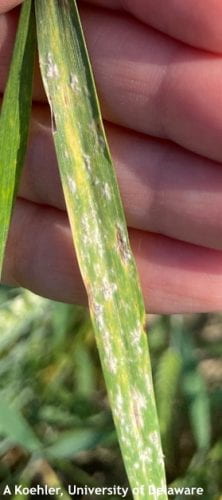Alyssa Koehler, Extension Field Crops Pathologist; akoehler@udel.edu
Wheat heads are continuing to emerge and will be flowering over the next 2 weeks. I have seen a delay in the emergence of anthers in wheat heads that started coming out early last week. In most cases, about 5% of anthers just started to be visible Thursday. Using a “very susceptible” variety choice, Sussex County is tracking at medium to high FHB risk (Figure 1). We have quite a bit of rain in the forecast this weekend, but cooler temperatures, which are not as favorable to FHB. However, these cooler temperatures may keep Powdery Mildew levels higher than we are used to seeing this time of year. Powdery mildew appears as white, fluffy growth on the leaf surface (Figure 2). Powdery Mildew grows best at temperatures 50-70°F and typically declines after temperatures are above 75°F. We have not had enough consistently warm temperatures to see Powdery Mildew fade out for the year. A number of fields have been dealing with low canopy Powdery Mildew waiting for fungicide application at anthesis. Depending how far away anthesis is, if Powdery Mildew has moved to the top of the canopy and at severe levels, an additional fungicide application may be warranted. Any of the products used for anthesis application for FHB should also have activity for Powdery Mildew, be sure to avoid products containing strobilurins that might have been used earlier in the season. Strobilurins should be applied before Feekes 8 growth stage to avoid risk of increased DON levels in wheat with FHB.

Figure 1. FHB Risk Model for May 5, 2022 (wheatscab.psu.edu)

Figure 2. White fluffy growth on powdery mildew on wheat leaf
